Centre Five: Bridging the Gap
Anna Parlane
I’d hazard a guess that many Melbournians’ primary point of engagement with Centre Five is a childhood memory of trying (and failing) to climb the slippery, curved surface of Inge King’s Forward Surge (1972–74) on the Arts Centre lawn. King was apparently fine with this. “Public sculpture should be used in some way,” she commented. “It didn’t even worry me when the kids used to run their skateboards up it. This sculpture is strong, and I know it can withstand any ill treatment so why not be part of the community?” Curator Jane Eckett’s Centre Five: Bridging the Gap at McClelland Sculpture Park and Gallery takes the group’s desire to be part of the community—to bridge the gap between art and its potential publics—as its core focus. The show surveys the work of the seven members of Centre Five, Vincas Jomantas, Julius Kane, Inge King, Clifford Last, Lenton Parr, Norma Redpath, and Teisutis Zikaras, focusing on their most active years in the 1960s and concluding with their final group exhibition, also held at McClelland, in 1973.
All but two (Redpath and Parr) of the Centre Five artists were war-time European migrants who were dismayed by the insipid cultural scene in their new home. Berliner Inge King famously found Melbourne “as lively as a glass of warm, flat beer” when she arrived in 1951. The exhibition focuses on the artists’ pragmatic response to this situation. The five-point program from which Centre Five derived their name aimed to build an audience and a support infrastructure for modern sculpture in Australia by: 1) staging exhibitions, lectures, and media interviews; 2) seeking better representation in public collections; 3) fostering a closer relationship with architects; 4) promoting a percent-for-the-arts scheme for public buildings; and 5) lobbying for sculpture-specific scholarships and fellowships.
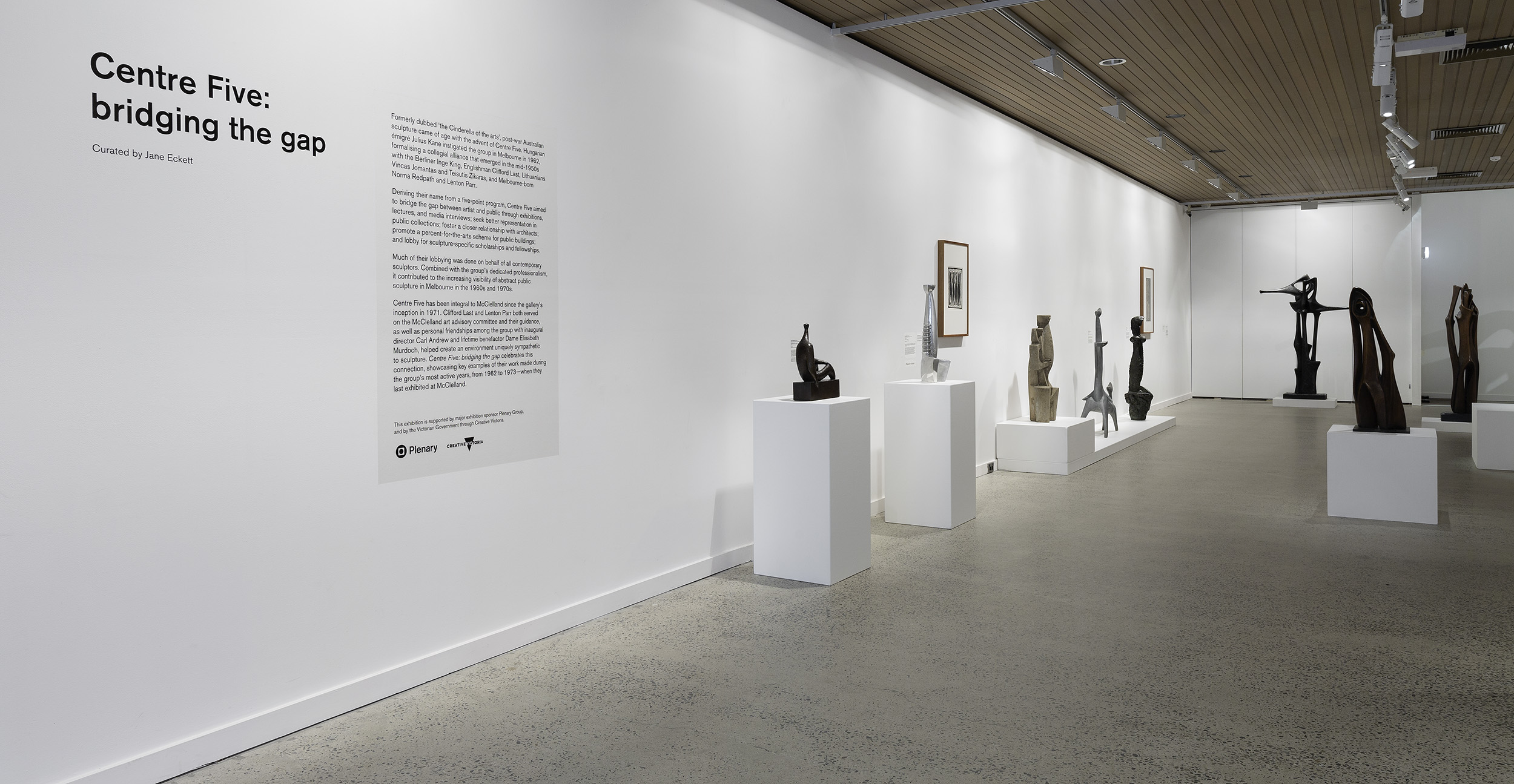
Backed by meticulous archival research, Eckett has traced the growth and professionalisation of the artists’ practices. Central to the show—and perhaps not given its due emphasis—is a display of photographs and other ephemera documenting Centre Five’s exhibitions and sculptural commissions. A series of black and white photographs showing their many commissioned works looking chic in their modernist architectural settings feels slightly sidelined in the space. However, Eckett was able to make strong connections between the exhibition and McClelland’s collection. The archival material and a 1969 film profiling the group, together with the maquettes, drawings, and smaller sculptures in the gallery, are linked to the large-scale fruits of the sculptors’ efforts, many of which are now permanently installed in the sculpture park outside. Eckett’s catalogue essay combs through the artists’ correspondence as they tirelessly networked, promoted the value of modern sculpture, and tried to initiate opportunities for large-scale projects. As she notes, “their proselytising efforts would eventually pay dividends for subsequent generations of Australian sculptors from the 1970s onwards.”
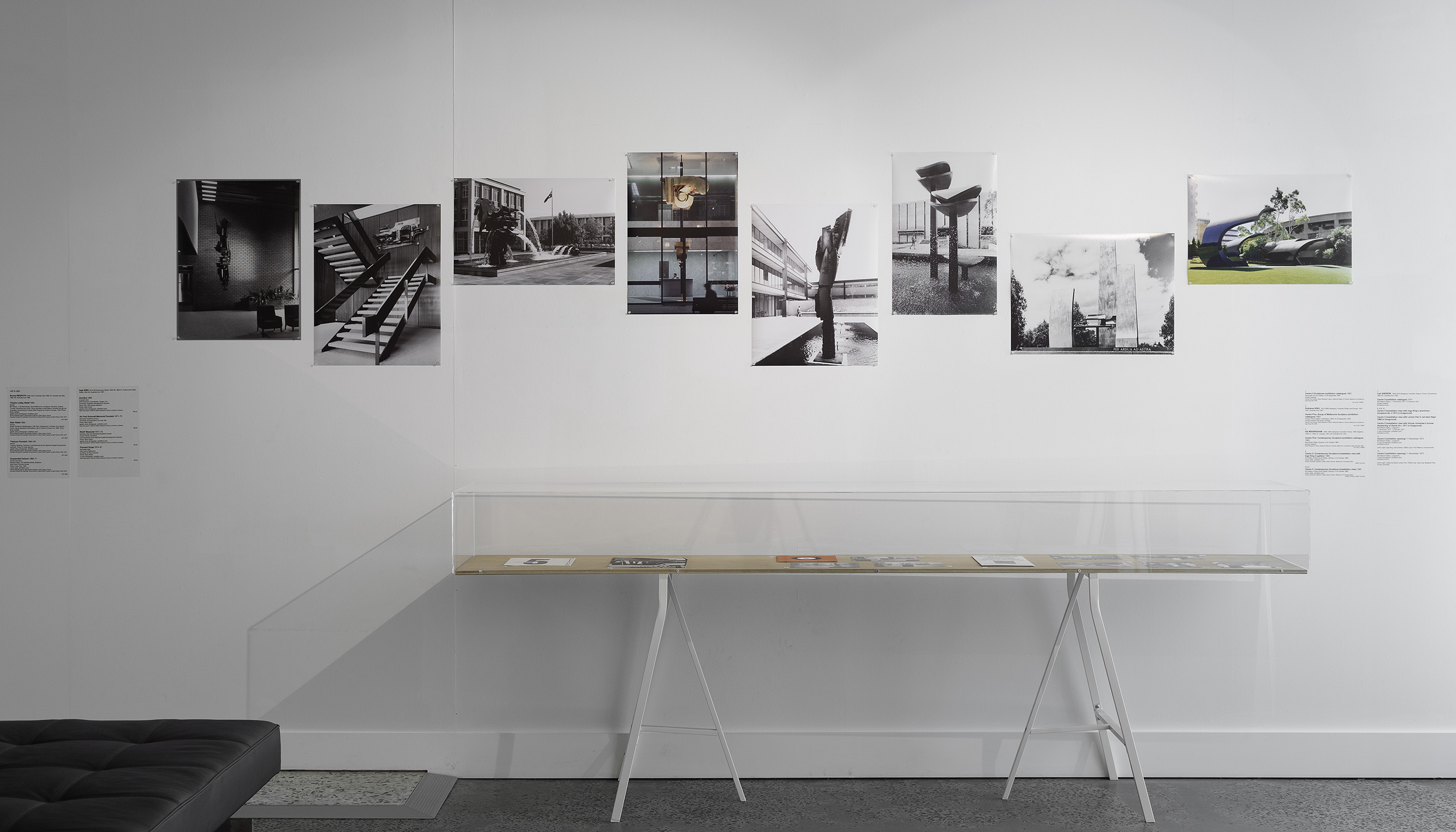
Centre Five: Bridging the Gap can be understood as a pre-history of Australia’s current embrace of contemporary public sculpture. From the emergence of the Mildura Sculpture Triennial (which, in its original incarnation as the 1961 Mildura Prize for Sculpture, was dominated by Centre Five artists— Norma Redpath won the major prize in both 1961 and 1964), to the sculptural commissions by Centre Five artists that adorned universities, public and corporate buildings through the 1970s, you might draw a line to the percent-for-art schemes that have resulted in substantial commissions for the new Metro Tunnel train stations and the Eastlink commissions that have transformed the toll road leading to McClelland “into Australia's largest sculpture park” (which, it is worth noting, includes King’s Red Rings (1972), finally realised at full scale in 2008).
It is telling, however, that Eckett’s survey concludes in 1973, the year of Centre Five’s final group show at McClelland and also of Mildura’s Sculpturscape ‘73. Graeme Sturgeon’s book Sculpture at Mildura quotes director Tom McCullough’s enthusiastic adoption of a new language to describe the new sculpture of the moment. The 1973 Triennial, McCullough explained, took place in a “post-Christo landscape … totally concerned with the outstallation of important works of art which define, react/respond to, contradict, transform, merge with or consciously ignore a set environment.” The Triennial became a testing ground and showcase for the anti-institutional site-specific, performative, earth art and post-object practices that in the 1970s overtook (while also benefiting from) Centre Five’s civic-minded, pragmatic, professional modernism. While Centre Five artists obviously didn’t stop practising—Redpath was producing major commissions like Landscape Caryatid (1980–85) into the 1980s and King’s monumental Rings of Saturn (2005–06) was installed at Heide as recently as 2006—in the early 1970s it was clear that the discourse around sculpture had shifted dramatically. Given that the conceptual practices of the 1970s are widely understood as a pivotal origin point for contemporary art, and also given the enthusiasm with which corporations and major development projects now commission public sculpture that tends towards the massive and spectacular, how does Centre Five’s work and legacy read now?

The group was closer to a professional association than a school or movement. They were brought together by shared professional ambitions and a belief in sculpture’s civic potential rather than any particular stylistic affinity. However, an art-historical narrative arc is nevertheless apparent in the exhibition. The first room focuses on sculptures by Kane, Zikaras, and Last, which work through concerns of the 1950s. Centre Five’s European origins are clear here, with all three sculptors negotiating the influence of Barbara Hepworth, Henry Moore, and in the case of Zikaras’ several extremely phallic elongated “figures,” Constantin Brancusi. Apart from some early anomalies—notably Kane’s mythic Equestrienne (1952), who I immediately and unreservedly adored for her pragmatic expression and her very chonky horse—the works all explore tensions between figuration and abstraction. A key tool in this exploration was primitivism, and several works pillage strategies non-Western artists have used for distorting and abstracting the figure. Kane’s Organic Forms (1962), for example, reminds me of a Papua New Guinean malanggan, and Zikaras’s drawing Figure with Arms Raised (1958) combines elements from different Māori customary carved figures: the beak-like head and sinuous body of a manaia is joined to limbs copied from an ancestral figure in a whare whakairo (carved house), with its distinctive wide stance and clawed hands and feet. The room is dominated, however, by Last’s elegant wooden biomorphs that are perhaps closer to surrealism than primitivism in their use of skeletal and bone forms.
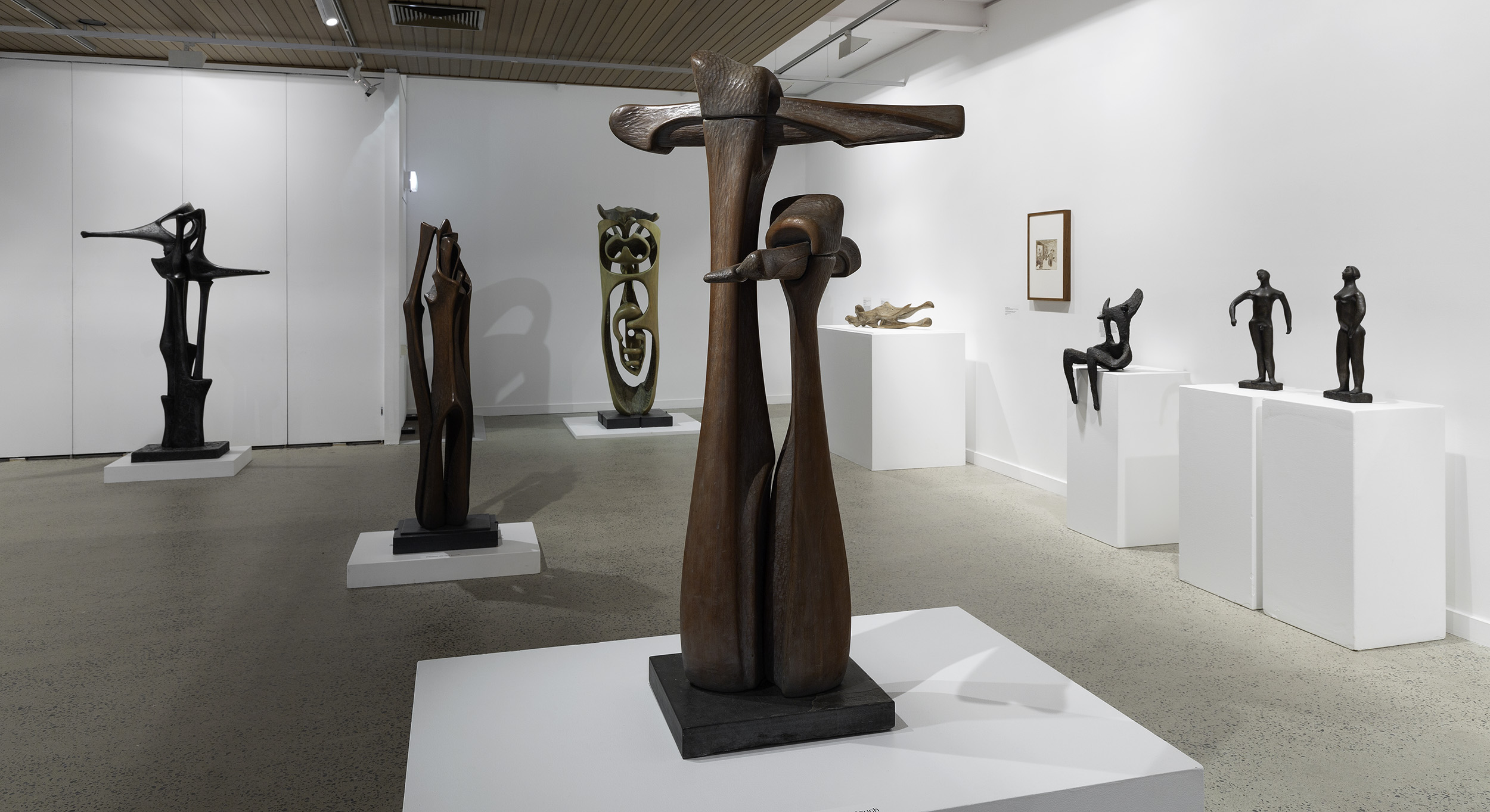
In the exhibition’s larger second room, works by King, Redpath, Parr, and Jomantas pick up on trends emergent through the 1960s and also demonstrate the artists’ increased ambitions to work on a larger scale. The sculptures here are not in plinth-bound dialogue with the figure so much as engaging with architecture or landscape—the fact that they are all nevertheless presented on plinths makes them feel very much like maquettes, a collection of scholarly footnotes to the full-size works in the sculpture park outside.
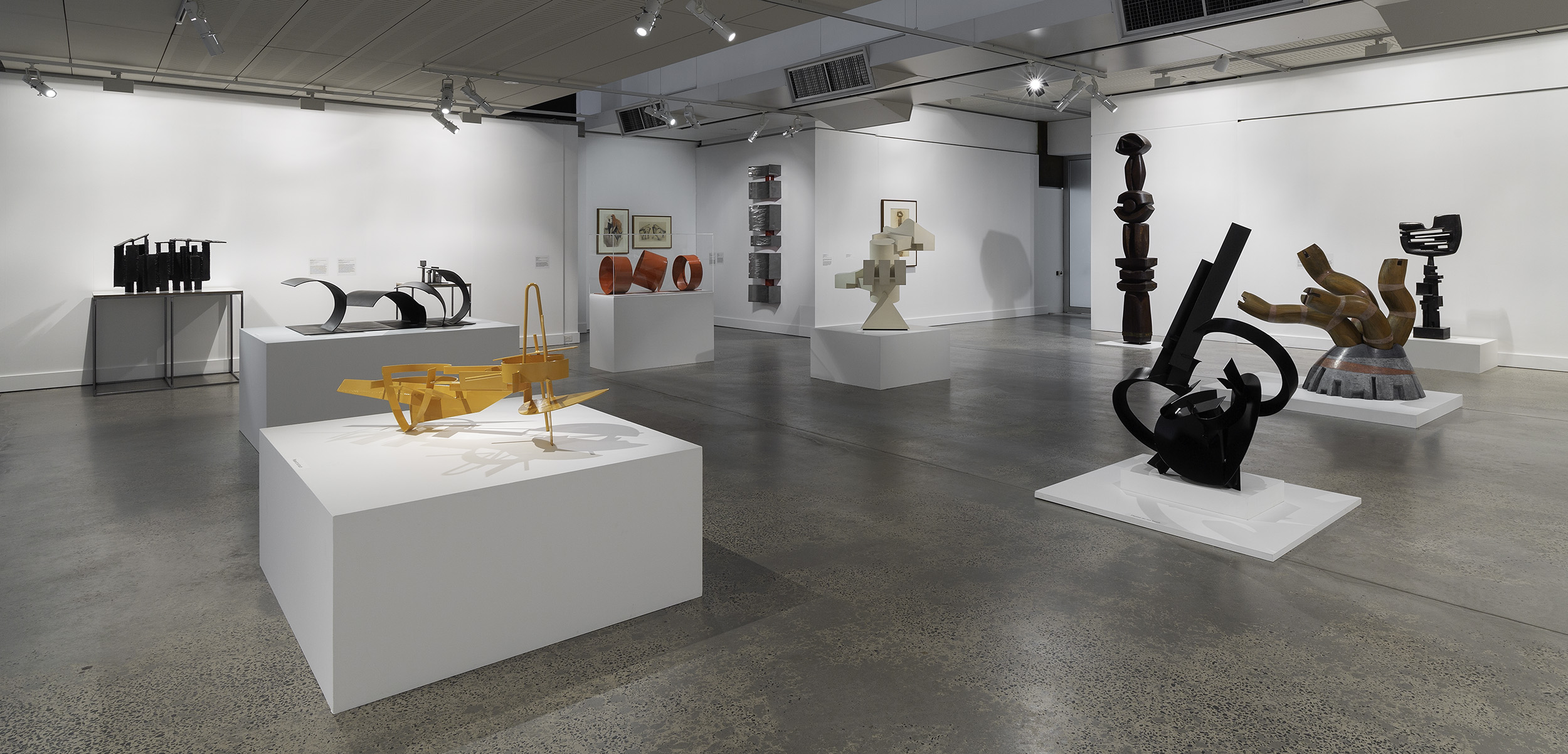
During the 1960s both Parr and King shifted away from organic forms and textured surfaces towards a harder-edged machine aesthetic, in line with the trend towards minimalist geometry which culminated in the NGV’s The Field in 1968. There are also affinities between some of Parr and Jomantas’s works. Parr’s welded steel Astrojet Sculpture (maquette for Astra) (1969), commissioned for the Astrojet Space and Science Centre at Tullamarine airport, for example, is juxtaposed with Jomantas’s untitled drawing for Pursuit of Scientific Knowledge (1962), a fountain produced for the ANU Physics Building. Both works articulate the scientific aspirations of their commissioners with spiky, caliper-like compositions of lines and arcs, evoking both precision instruments and movement through space. Eckett’s selection hews closely to a developmental narrative tracking a shift away from stylised figuration towards works that are, if not minimalist, then environmental or industrial in scale or orientation. However, occasional respite from this narrative is provided by idiosyncrasies like Jomantas’ truly bonkers polychrome sculpture Awakening of Giants I (1967). Like Kane’s Equestrienne, it was clearly just too good not to include.
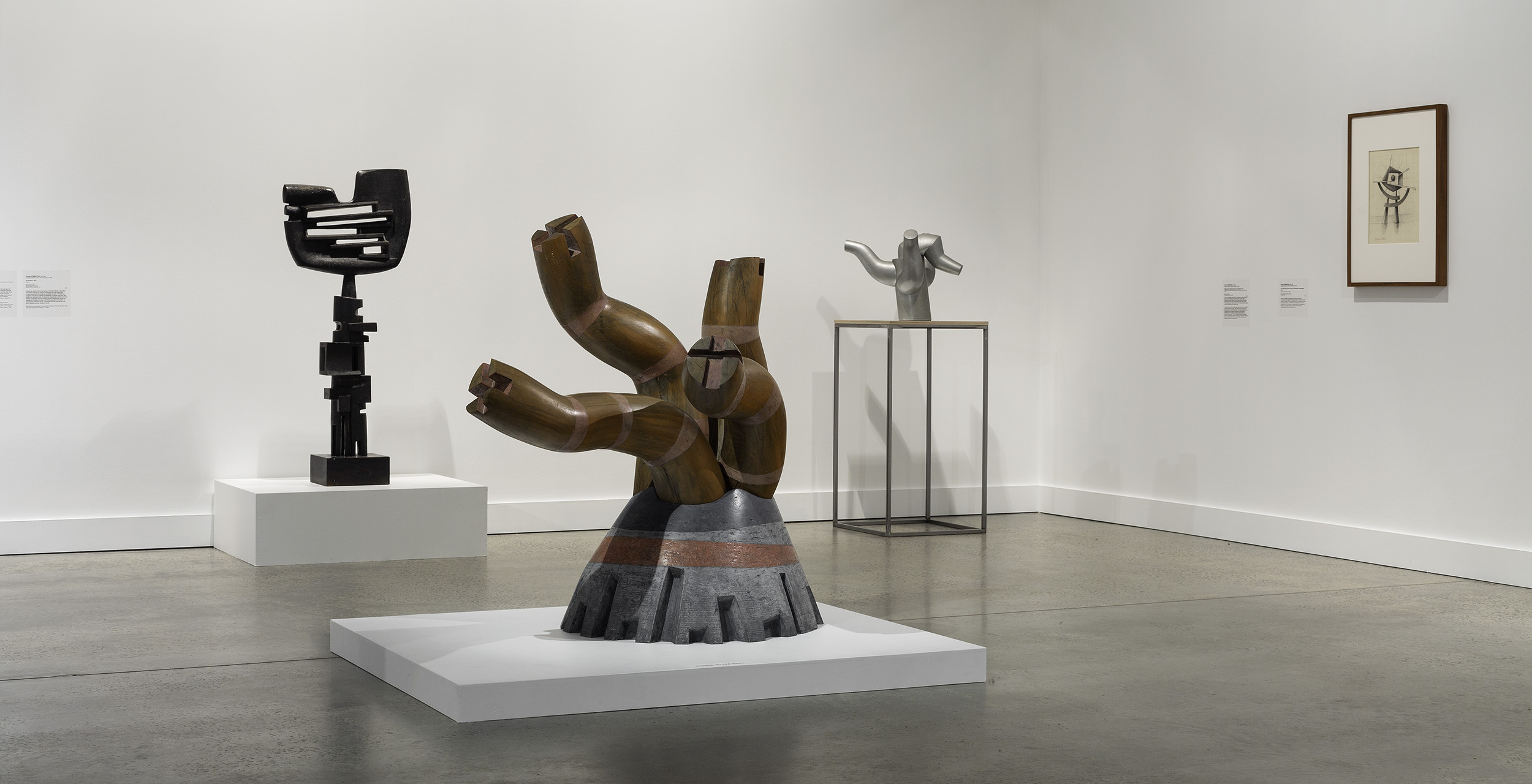
Given the way that the shift initiated by minimalism and conceptual art lurks ominously in the background of the exhibition, I was particularly interested by King’s Wall Sculpture I (1968), which is almost painfully close to Donald Judd’s cantilevered and wall-mounted “stacks” of the 1960s. Eckett’s wall label attempts to differentiate King’s approach from Judd’s by emphasising her use of ground steel to create the effect of shimmering, swirling movement. However, the juxtaposition with Jomantas’s Poet (1961) suggests an alternative reading in which King’s Wall Sculpture I restages the primitivist totemic verticals of her and her colleagues’ earlier works using the new, sharp-edged minimalist idiom, thereby effectively smuggling a figurative element into Judd’s militantly anti-expressive and anti-figurative sculptural language.
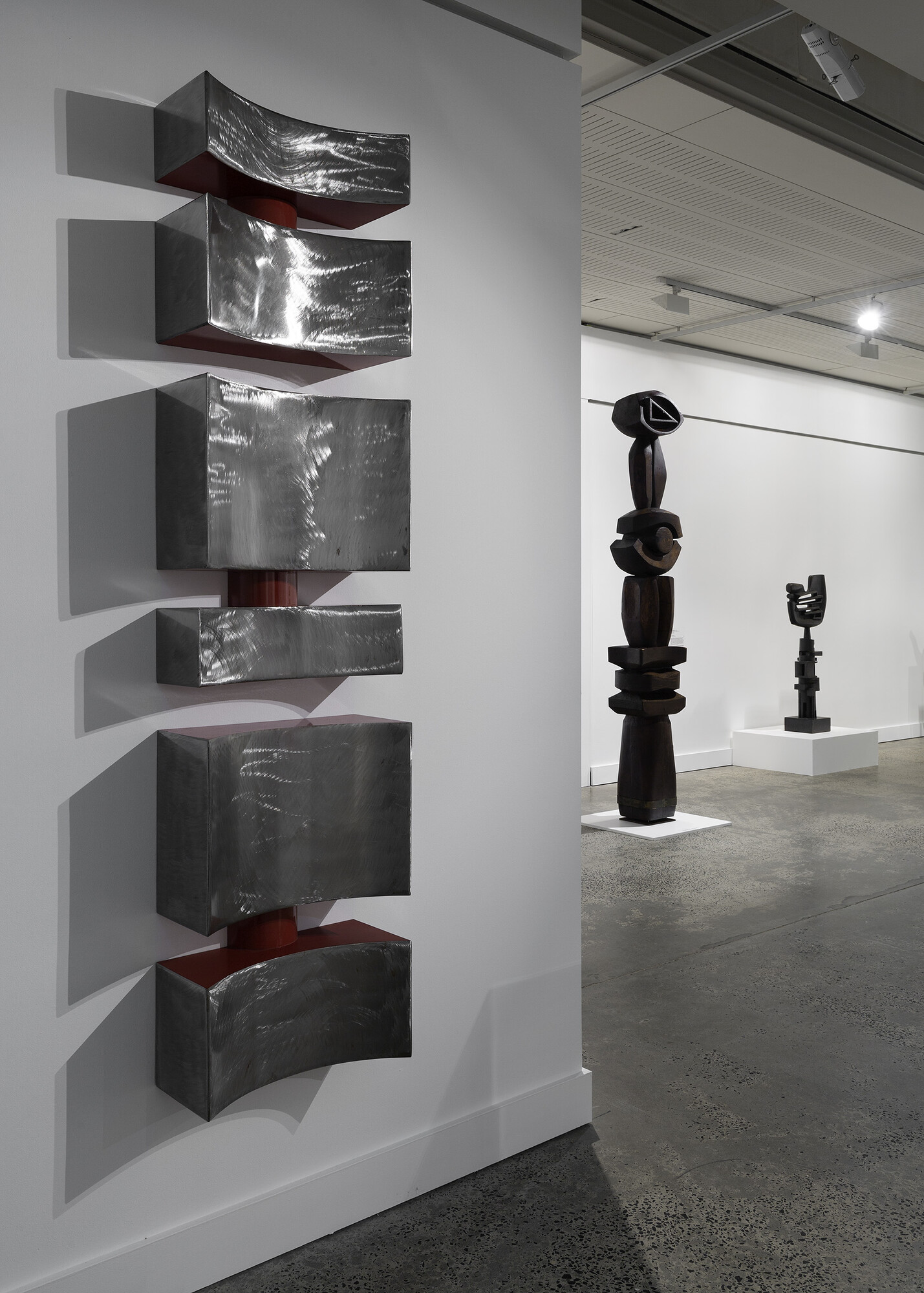
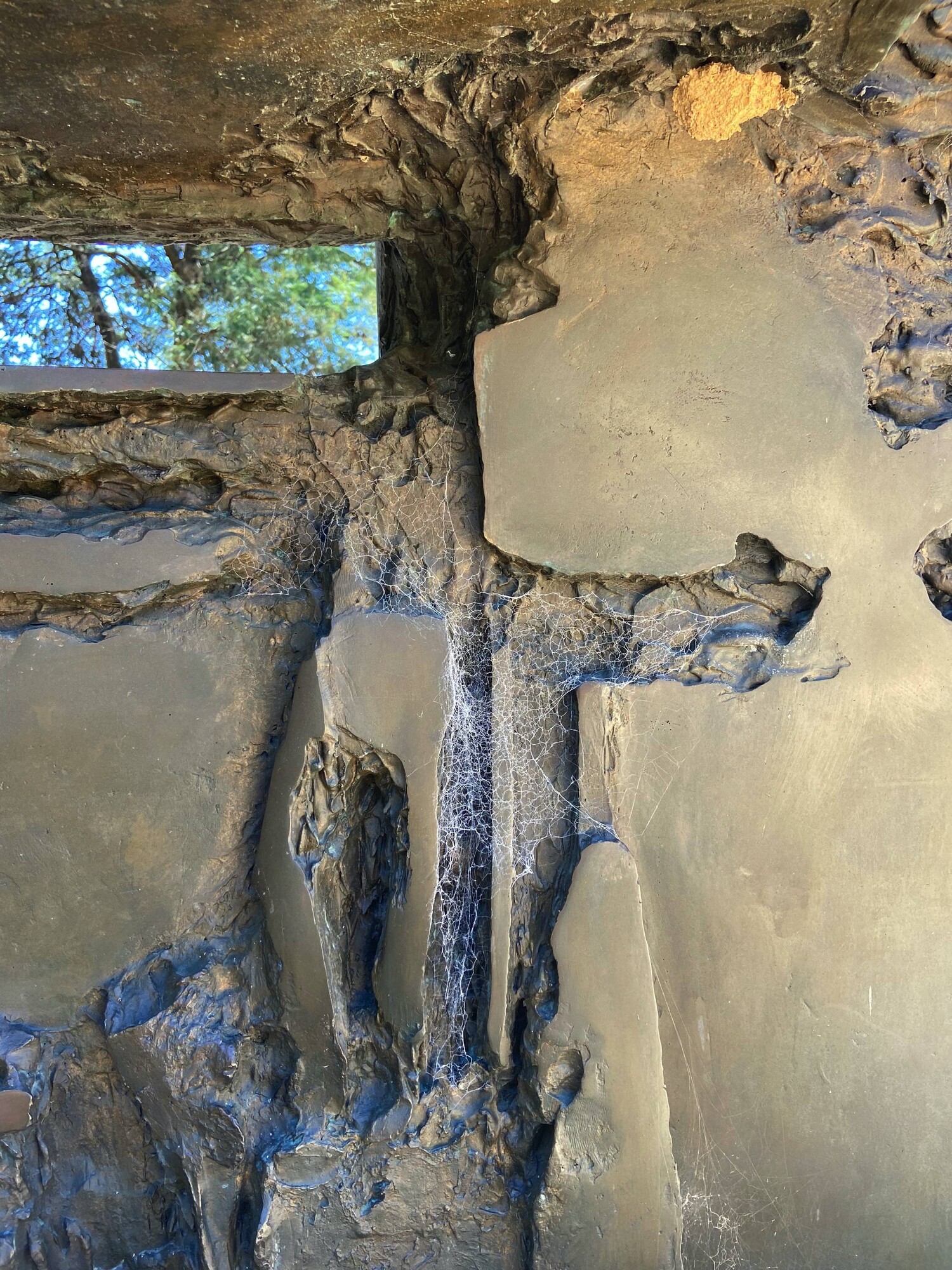
King’s works of the 1970s, like the aforementioned Red Rings and Forward Surge, were designed to mediate between the body of the viewer and the surrounding environment. This goal was also central to Redpath’s practice. Unlike others in Centre Five, Redpath didn’t go in for hard-edged minimalist geometry, instead sticking with her highly textured, slab-like forms that so gorgeously articulate not only the landforms they resemble but also the materiality of bronze and the casting process. For me, the highlight of the show was Redpath’s work, and particularly the link Eckett established between her smaller sculptures inside the gallery and the larger works Desert Arch (1964), Theatre Lobby Relief (1964), and Paesaggio Cariatide (Landscape Caryatide) (1980–85), which are all permanently installed in the sculpture park and visible through the gallery’s window. There’s an organic quality to Redpath’s works that reminded me of the skeletal forms of Last’s carved wood sculptures, but which she expanded to take on the weight and monumentality of architecture or a rock formation. It seems entirely appropriate, for example, that insects have made their homes in Desert Arch’s crevices. Redpath’s work feels self-assured but not at all self-contained; it has a quality of porousness to its surrounding environment.
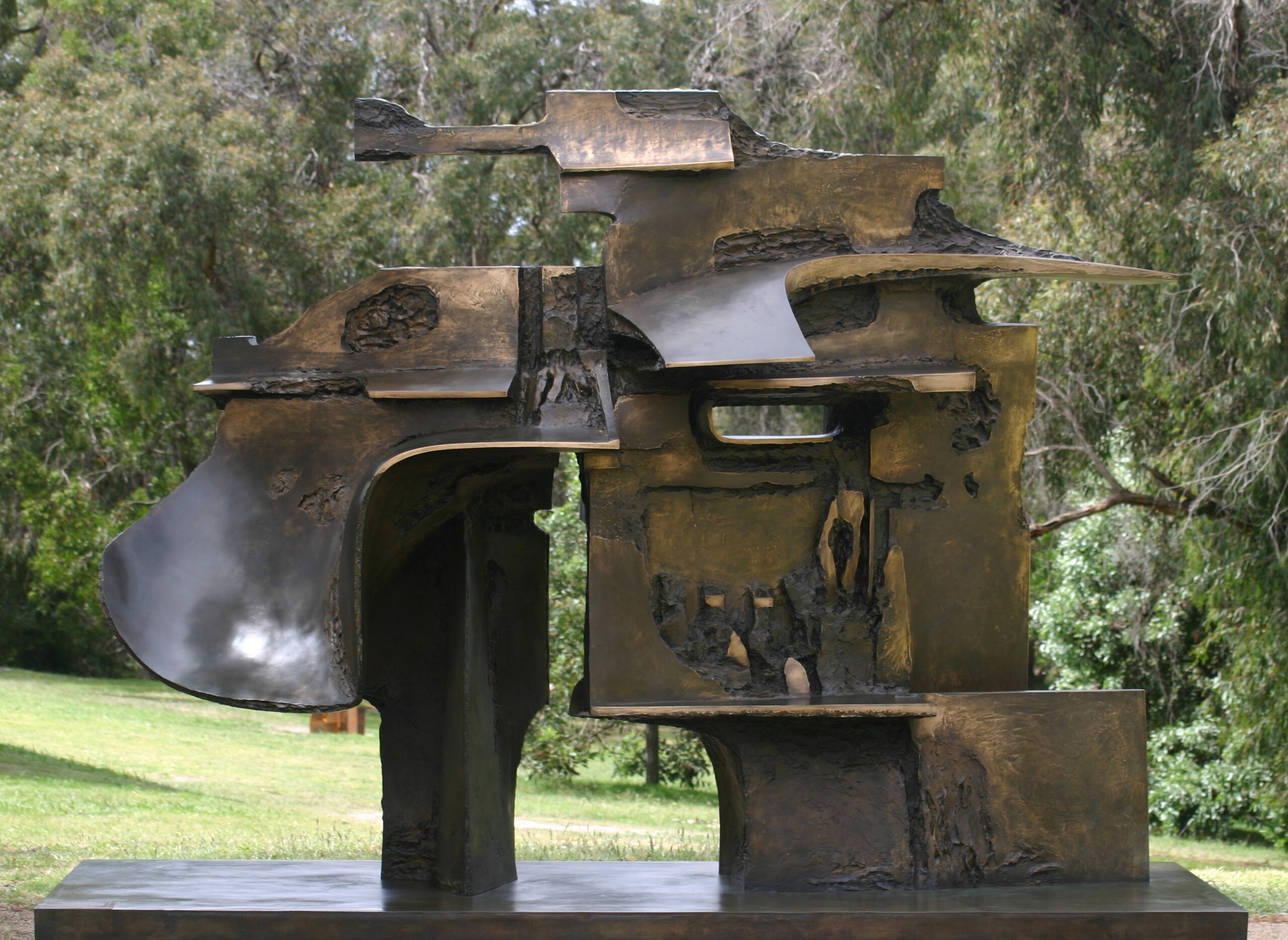
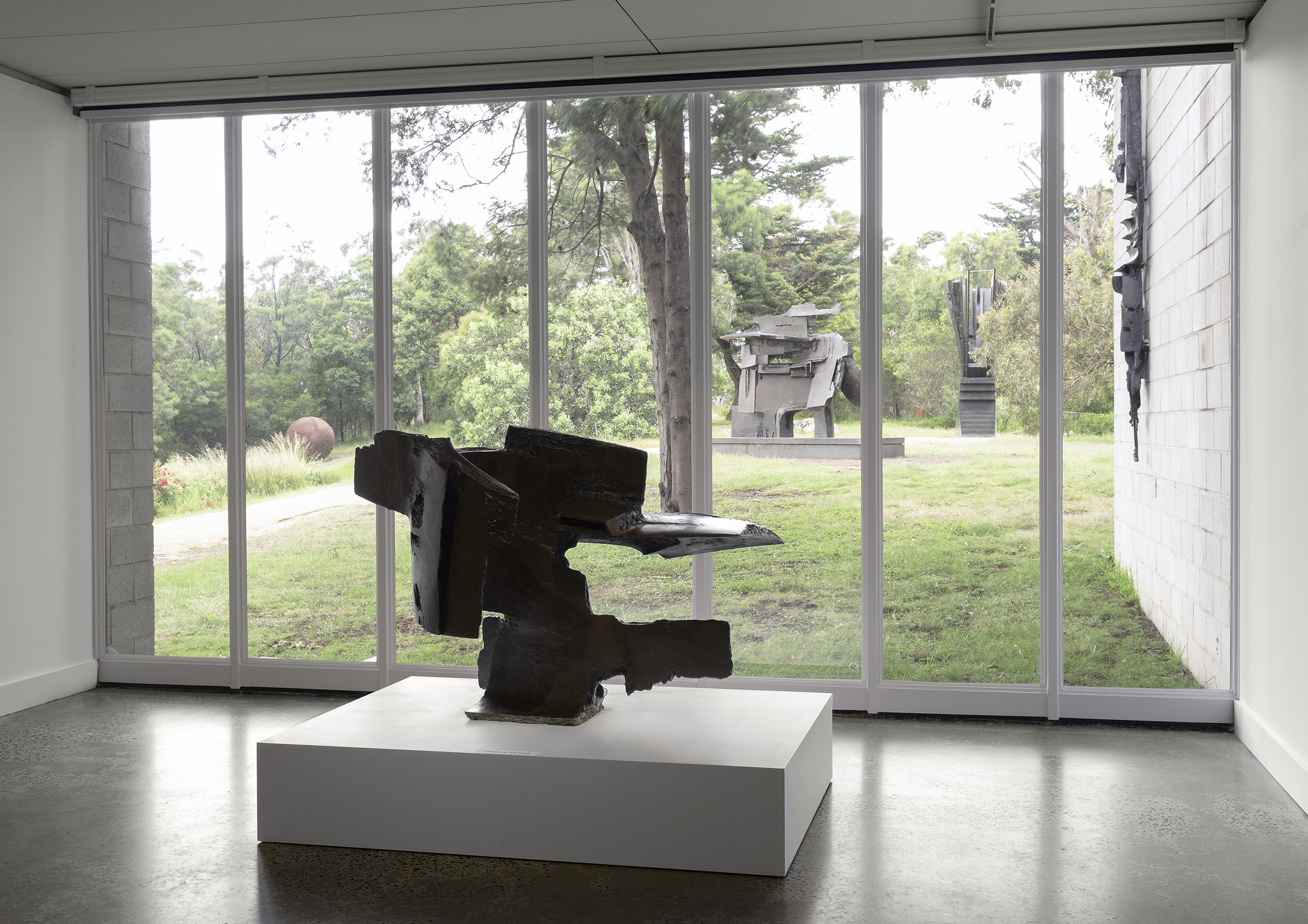
Many of the Centre Five works that are now in McClelland’s collection were originally commissioned for other sites. Zikaras’ ETA Fountain (1961) and GPO Fountain (1964), Parr’s Customs House Screen (1963–66) and Astra (1970), and Redpath’s Paesaggio Cariatide (Landscape Caryatide) have all been relocated to a gentle retirement in McClelland’s bucolic bushland setting. The legacy of these artists obviously includes the infrastructure of support for contemporary sculpture that they worked so hard to build. However, I was also interested to see how engaging with their work required me to reconsider and perhaps soften my presumptions about a “break” in sculptural practice in the late 1960s and early 70s. Centre Five’s long-standing attention to the figure extended from its abstraction into biomorphic form through to a more phenomenological interest in sculpture’s relationship to the viewer’s body and the shared space of their encounter. It seems that King and Redpath’s large-scale works in particular built upon this interest, paying close attention to the relationships between the sculpture, the surrounding environment and the local community. A degree of flexibility and openness to the ways in which an artwork might integrate into both community and site is crucial for an artist working on a site-specific commission but also indicates a lack of preciousness about the artwork, a refusal to see it as a pristine, timeless object, which feels very contemporary. I can’t imagine, for example, Donald Judd ever being cool with kids skateboarding on his works.
Anna Parlane is a lecturer in art history and theory at Monash University.


